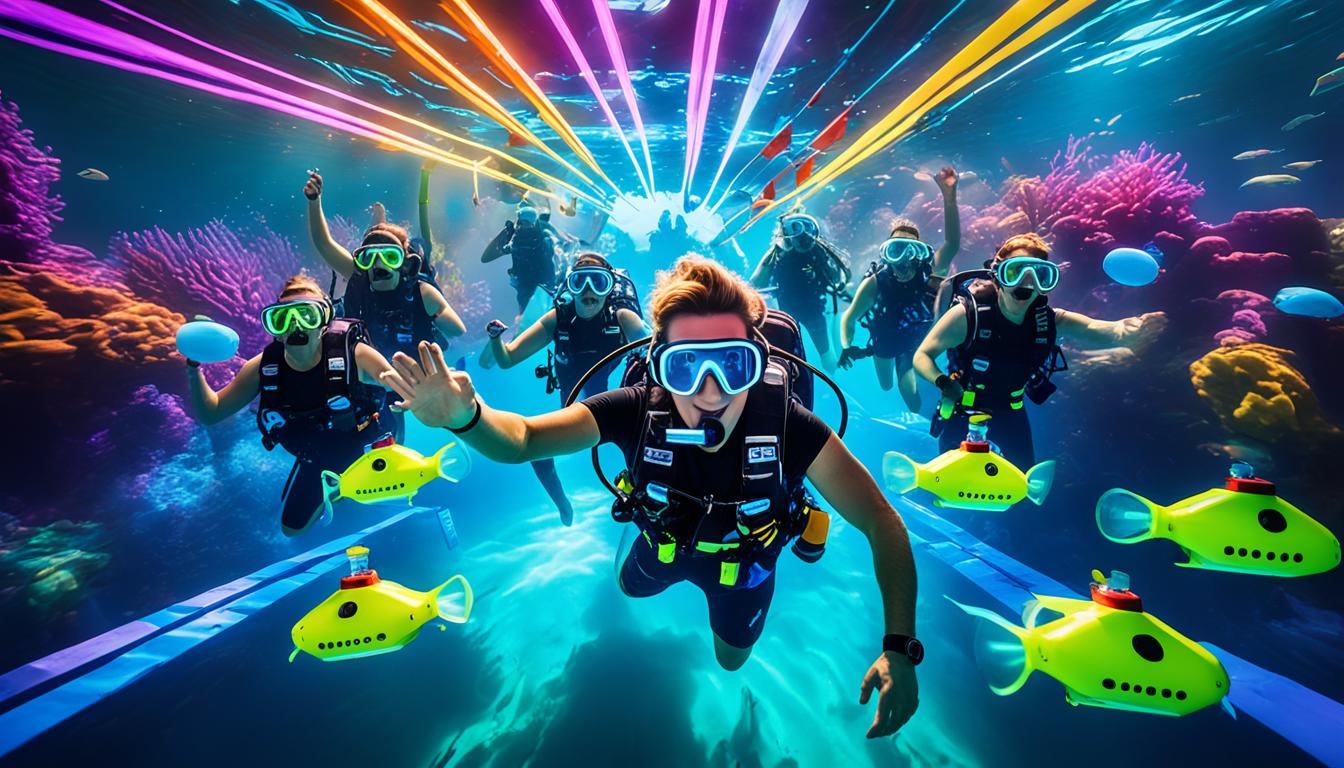Key Takeaways
- Understand the unique features of the Trident underwater drone that make it a powerful tool for exploration.
- Follow a comprehensive pre-dive checklist to ensure your Trident is sea-ready.
- Learn the essentials of battery maintenance to keep your drone diving longer.
- Discover how to navigate effectively during dives and maintain clear visibility in challenging conditions.
- Know the post-dive cleaning steps and common troubleshooting tips to keep your Trident in top condition.
Dive into Complete Care for Trident Underwater Drone
When you have a Trident underwater drone, you hold the key to unlocking the mysteries of the deep. But with great power comes great responsibility, and taking care of your Trident is crucial for its performance and longevity. Whether you’re a seasoned explorer or just dipping your toes into the waters of drone operation, this guide will navigate you through the essentials of caring for your underwater companion.
What Makes Trident Special for Underwater Explorers?
The Trident underwater drone isn’t just any remote-operated vehicle; it’s a robust piece of technology designed for the depths. Its agility and durability make it perfect for a range of underwater activities, from marine research to treasure hunting. But what sets it apart?
- High maneuverability for tight spaces and intricate underwater landscapes.
- Advanced camera systems for clear, high-definition footage.
- Long battery life for extended exploration sessions.
With these capabilities, the Trident can take you places you’ve only dreamed of, revealing the secrets beneath the waves.
Key Components of Your Trident Drone
Before we dive into care and maintenance, let’s get familiar with the key components of your Trident drone:
- Chassis: The durable body that houses all critical components.
- Propulsion: Thrusters that give the Trident its speed and agility underwater.
- Battery: The power source that fuels your underwater adventures.
- Camera: The eyes of your drone, capturing everything it sees beneath the surface.
- Tether: The lifeline that connects your drone to the surface, allowing for control and data transmission.
Knowing your drone inside and out is the first step to becoming a master of underwater exploration.
Before Each Dive
Preparation is key. Before you let your Trident slip beneath the waves, a thorough check is essential to ensure everything is in working order. This not only protects your investment but also guarantees that you won’t miss a moment of underwater action.
Pre-Dive Checklist
Here’s what you need to do before each dive: Ensure your underwater drone is ready for operation.
- Inspect the chassis for any cracks or damage.
- Check the propellers for debris and ensure they spin freely.
- Verify the battery is fully charged and properly installed.
- Ensure the camera lens is clean for the clearest view.
- Test the tether’s connection for secure data transfer.
Tick off these steps, and you’re ready to explore the deep blue.
Battery Care and Charging Practices
The heart of your Trident drone is its battery. Proper care is not just about longevity; it’s about safety too. Here’s how to keep it in peak condition:
- Charge the battery fully before each use but avoid overcharging.
- Use only the charger provided with your Trident to prevent damage.
- Store the battery in a cool, dry place away from direct sunlight.
Most importantly, never dive with a battery that’s not at full capacity. It’s not just about the length of your dive; it’s about having enough power to return safely.
During the Dive
Once your Trident drone is submerged, the real adventure begins. But with the thrills come the need for vigilance. As you navigate the underwater realms, remember to monitor your drone’s systems continuously.
Navigating with Precision
Smooth sailing isn’t just about the thrill; it’s about safety too. Keep these pointers in mind:
- Always be aware of your Trident’s surroundings to avoid collisions.
- Use the drone’s buoyancy control to maintain the correct depth.
- Steer clear of underwater currents that could sweep your drone away.
By staying in control, you ensure both the safety of your Trident and the success of your mission.
Maintaining Visibility and Handling Murky Waters
Even the clearest waters can turn murky in an instant. Here’s how to maintain visibility: consider exploring the educational applications of underwater drones to understand how they can help navigate and visualize in less-than-clear conditions.
- Adjust the lighting on your Trident to compensate for low visibility conditions.
- Move slowly to allow sediment to settle and avoid kicking up debris.
- Use the live feed from your Trident’s camera to navigate when your line of sight is compromised.
Clear vision leads to incredible discoveries. So, keep those lenses clean and lights bright.
After the Dive
Once you’ve surfaced, the care for your Trident isn’t over. Post-dive maintenance is crucial to ensure your drone is ready for its next adventure.
Post-Dive Cleaning and Maintenance
After each dive, follow these steps to keep your Trident in shipshape:
- Rinse your drone with fresh water to remove any salt, chlorine, or debris.
- Check the propellers and remove any entangled materials.
- Dry your drone thoroughly, especially the connectors and tether points.
A clean drone is a happy drone, and it’s the best way to avoid long-term damage.
Troubleshooting Common Issues
If you encounter problems, don’t panic. Here’s how to handle common issues:
- If the drone isn’t responding, check the tether connection and ensure it’s secure.
- For unresponsive propellers, inspect for obstructions and clear any debris.
- Should the camera feed become disrupted, verify the integrity of the data connection.
Remember, most issues have simple solutions, so take a deep breath and tackle them one by one. For more detailed troubleshooting, refer to our underwater drone guide.
Long-Term Care and Storage
Your Trident may be tough, but it still needs some TLC when not in use. Long-term care and storage are the cornerstones of drone longevity.
Here’s how to ensure your Trident stands the test of time:
- Store your drone in a cool, dry place, away from direct sunlight.
- Keep the battery charged to an optimal level, usually around 50%, for extended storage.
- Occasionally power up your drone during long storage periods to keep the electronics in good working order.
Proper storage is the silent guardian of your Trident’s lifespan.
Safeguarding Electronics and Corrosion Prevention
Water and electronics don’t mix, so corrosion prevention is key. Protect your drone’s heart with these tips:
- Apply a thin layer of silicone grease to metal contacts to ward off rust.
- Inspect the seals and gaskets regularly and replace them if they show signs of wear.
- Consider using corrosion inhibitors if you frequently dive in saltwater.
With these measures, you’ll keep the dreaded rust at bay.
Proper Storage Techniques to Preserve Integrity
When it’s time to put your Trident away, do it right:
- Coil the tether loosely to prevent kinks and damage.
- Remove the battery if you won’t be using the drone for an extended period.
- Avoid placing heavy objects on top of the drone to prevent deformation.
Think of storage as a hibernation period where your drone dreams of its next dive.
Upgrades and Modifications
Your Trident drone is a marvel as is, but there’s always room for enhancement. Upgrades can open new doors of exploration.
When to Consider Upgrades
Upgrade your Trident when:
- You need improved functionality, like enhanced cameras or sensors.
- There’s wear and tear on key components that affect performance.
- New technology becomes available that can elevate your diving experience.
Remember, upgrades should be about meeting your needs, not just about having the latest tech.
Adding Accessories for Enhanced Exploration
Accessories can transform your Trident’s capabilities. Consider adding:
- Additional lighting for deeper, darker dives.
- Sonar systems for mapping the seafloor.
- Sample collection tools for scientific research.
Choose accessories that align with your diving goals, and you’ll unlock even more underwater secrets.
Dealing with Wear and Tear
Even the sturdiest drones experience wear and tear. It’s an inevitable part of the journey, but it doesn’t have to be the end of the road. For owners of the Trident underwater drone, understanding how to maintain your device can help extend its lifespan.
Recognizing Signs of Wear
Keep an eye out for:
- Cracks or warping on the chassis.
- Stiff or noisy propellers.
- Fading or flickering lights.
Catching these signs early can save you from bigger problems down the line. For more detailed guidance, check out our article on maintenance and care of underwater drones.
Complete Care for Your Trident Underwater Drone
Wear and tear is normal, but it’s not something to ignore. Addressing it promptly means your Trident will be ready for many more dives. If you’re unsure whether to repair or replace a part, consult with the manufacturer or a professional. They can help you make an informed decision based on the severity of the wear and the cost of replacement versus repair.
Repair or Replace? Making the Right Decision
When faced with wear and tear, consider:
- The cost of the part versus the cost of a new drone.
- Whether the damaged part affects the drone’s performance or safety.
- If the part is under warranty or if the drone is still supported by the manufacturer.
These considerations will help you decide whether to repair your Trident or invest in a new one.
Understanding the Impact of Environment and Depth
Every body of water is different, and your Trident drone needs to adapt to various conditions. Understanding the impact of the environment you’re diving in is crucial for the care of your drone.
Adapting to Different Water Conditions and Temperatures
Whether you’re diving in the tropics or exploring icy waters, temperature can affect your Trident’s performance. Here’s what to keep in mind:
- Check the manufacturer’s specifications for temperature ranges.
- Be aware that battery life can decrease in colder water.
- Ensure seals and gaskets are in good condition to prevent leaks.
Adapting to the water conditions ensures your Trident performs at its best.
The Depth Factor: Knowing Your Limits
The deeper you go, the more pressure your Trident will face. It’s designed to handle the depths, but it’s essential to know its limits:
- Always check the maximum depth rating before a dive.
- Descend slowly to allow your drone to adjust to the increasing pressure.
- Avoid exceeding the depth limit to prevent damage to the drone’s structure and components.
Respecting these limits will help protect your Trident from the intense pressures of deep-water exploration.
Best Practices for Ensuring Drone Longevity
To keep your Trident drone exploring for years to come, it’s important to establish a routine for inspections and updates. This not only keeps the drone functioning optimally but also ensures that you’re always ready for the next dive.
Routine Inspections and Firmware Updates
Regular inspections and keeping the firmware up to date are vital:
- Inspect your drone for physical damage or wear after each dive.
- Keep the firmware updated to ensure you have the latest features and bug fixes.
- Check the manufacturer’s website regularly for updates and support documentation.
These simple steps can significantly extend the life of your Trident.
Expert Tips for Frequent Flyers
For those who use their Trident drone regularly, here are some expert tips:
- Keep a logbook of all your dives, noting any issues or observations.
- After several dives, take the time to do a more thorough inspection.
- Stay engaged with the community for the latest tips and best practices.
These practices will help you stay ahead of maintenance and get the most out of your Trident.
Community and Support
The underwater drone community is a treasure trove of knowledge and experience. Whether you’re troubleshooting an issue or looking for dive spot recommendations, the community is an invaluable resource.
Leveraging the Drone Community for Tips and Tricks
Here’s how to get the most out of the community:
- Join online forums and social media groups dedicated to underwater drones.
- Attend meetups and workshops to learn from experienced pilots.
- Share your own experiences and learnings to give back to the community.
The community is your support network, so engage actively and contribute your insights.
Finding Help: Support Resources
If you run into trouble with your Trident underwater drone, there are several avenues for support:
- Consult the user manual for troubleshooting tips and maintenance guidelines.
- Contact the manufacturer’s customer service for technical support.
- Reach out to the community for advice and shared experiences.
With these resources at your disposal, help is never far away.
Frequently Asked Questions (FAQ)
Here are some quick answers to common questions about Trident drone care:
How often should I charge my Trident drone’s batteries?
Charge the battery fully before each dive, but avoid leaving it on the charger once it’s full. For long-term storage, maintain the battery at 50% charge and top it up every few months.
Can Trident underwater drones be used in saltwater environments?
Yes, Trident drones can be used in saltwater, but always rinse with fresh water after each dive to prevent corrosion.
What is the maximum depth Trident drones can safely explore?
The maximum depth for Trident drones is typically around 100 meters, but always check the specific model’s rating before diving.
Are there any user-upgradable parts on the Trident drone?
While the Trident is a well-equipped drone, some parts may be upgradable. Check with the manufacturer or the community for compatible upgrades.
What should I do if my Trident drone starts showing signs of corrosion?
If you notice corrosion, clean the affected area with fresh water and a soft brush. Apply corrosion inhibitor and check the integrity of seals and gaskets. If corrosion persists, seek professional advice.
By following this comprehensive guide, you’ll ensure that your Trident underwater drone remains a reliable and powerful tool for your underwater explorations. Happy diving!
Option B is not possible as the paragraph content was not provided. Please provide the paragraph content for further assistance.






